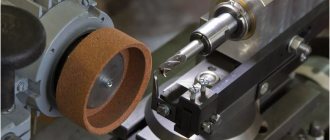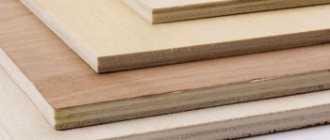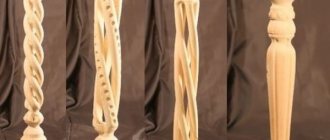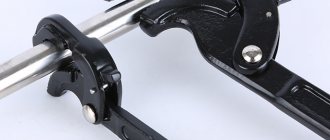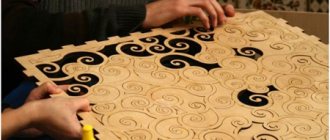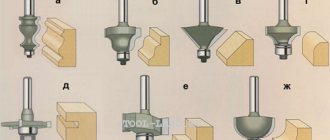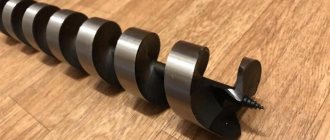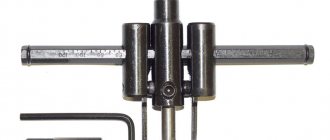A jigsaw is a hand-held tool designed for cutting various materials at home. With its help you can get straight, round, oval, and curly cuts. Moreover, the tool is able to cope not only with wood, but also with materials of varying strength. However, in order to achieve an accurate cut, you need to know the features of preparing the tool for work, and how to use a jigsaw correctly. Otherwise, the final result will differ from the desired one.
To cut thin and thick materials you need different jigsaw files
General cutting principles
It should be understood that a jigsaw produces an uneven cut. And to minimize the spread of the saw, you don’t need to make any special efforts when working with the tool. Simply press it to the surface of the material and set the direction of movement. The slower the cutting, the higher its quality.
Other general recommendations on how to use a jigsaw:
- During the cut, you need to constantly monitor the sharpness of the file and, if necessary, replace it in a timely manner. As soon as it becomes dull, the instrument begins to behave unpredictably.
- You should monitor the temperature of the cutting surface and avoid overheating. After all, this leads to rapid wear of the saw teeth.
- There are many types of jigsaw files. And each of them is designed for a specific type of material. To do quality work, you need to take this into account.
- Its functionality directly depends on the power of the tool. The higher this indicator, the more types of materials it can cut.
- Files with large teeth should be used for thick materials, and with small teeth - for thin materials.
- To get the most even seam, you should use additional devices such as a side stop, a jig, or a guide rail. This will allow you to move the tool through the material as smoothly as possible.
Important! As a guide when working with a jigsaw, you can choose any material with a smooth edge; the main thing is to align it correctly and secure the supporting end.
Nuances of an electric jigsaw
Modern manufacturers produce various models of jigsaws. The design of any type of tool consists of the following basic elements:
- Cutting blade. All electric jigsaws are equipped with a special file, which is used to cut the material. The processing process is carried out due to the rapid reciprocating movements of the cutting element. Moreover, depending on the model, the device makes from 43 to 58 revolutions per second.
- Support sole. This design detail ensures cutting accuracy. For most manufactured electric jigsaws, the guide plane rotates at any convenient angle up to 45 degrees. Some models have a fixed slope value.
- Engine. An electric tool is necessarily equipped with a special driving system that drives the rotating mechanism. The greater the power of the device, the higher its operational capabilities.
- Holder. This element allows you to keep the tool in the correct position during the entire working process.
Some models of electric jigsaws have additional equipment. This could be a backlight or devices for automatic chip removal. Many tools have cut regulators, which make it possible to independently set the rotation speed of the cutting element for each individual type of material being processed.
Features of preparing a jigsaw for work
At the stage of preparing the tool for work, you need to inspect it for damage and check the integrity of the power cable. You also need to immediately prepare all the files that may be needed to complete the task and set up the appropriate modes.
Before cutting, mark the material.
When purchasing, it is better to choose a tool equipped with a laser guide.
Preparatory work
Before you start cutting with a jigsaw, you need to decide what kind of design or pattern you want to create on the plywood. To visualize the image, it is most convenient to transfer it to plain paper. If the item is large (for example, a voluminous box or a figured shelf), an ordinary A4 sheet of paper will not be enough. In this case, you should take whatman paper in A1 or A0 format.
Preparing for cutting Source obi.ru
Once the edges of the future work of art are drawn with a pen or a thin marker on paper, you can apply it to plywood. To do this, just cut out the drawn figure, attach it to the plywood and trace it with a pencil. To be able to correct an unevenly applied contour, it is better to use a simple pencil and have an eraser ready, just in case.
The outline should be applied to the back side of the plywood from which you plan to cut the figure. To prevent the design from moving away during transfer, you can attach it with tape or glue (provided that the glue can be easily removed from the surface). For convenience, you can shade the entire inside of the future product so as not to accidentally cut off more than necessary.
By the way, another way to transfer a design to plywood is to use carbon paper or carbon paper. It needs to be placed between the base and the paper model (template for cutting with a jigsaw). After this, all that remains is to circle all the lines again.
Secret! To cut a shape as accurately as possible using a jigsaw, it is better to position the cutting lines so that they run across the fibers of the material.
Example template Source pinimg.com
How to work with a jigsaw: features and rules
Depending on the type of material, the rules for making a cut are slightly different. And to avoid mistakes, you need to familiarize yourself with how to work with a jigsaw in a given case.
How to cut metal
When cutting metal, you should use a fine-toothed file. For thin and soft materials such as copper, aluminum, the speed can be set higher. A level above 750 W is considered optimal. And to reduce the friction force, you should periodically drip oil during operation.
Important! When cutting sheet metal, it is better to place plywood under it, which will reduce vibration.
How to cut wood, chipboard, plywood
The largest range of files is presented specifically for cutting these materials. But they must be used for their intended purpose. The number of strokes should be set based on the maximum values of the tool.
To make a cut in this case, you will need files with large teeth from 2 to 6 mm. The more complex the type of work, the smaller their size. A straight cut can be made at high speeds, and with a curly cut, the rotation speed can be reduced.
Having mastered the basic principles of how to properly work with an electric jigsaw on wood, plywood and chipboard, not only an adult, but also a child will be able to cope with such a task.
How to cut metal tiles
In this case, the greatest difficulty is the metal tile profile. And, in order to make the cut correctly, it is recommended to secure a sheet of material between the bars on both sides. This will eliminate vibration and create a certain gap for comfortable work.
Important! In order not to spoil the metal tile coating during the cut, you need to wrap the sole of the tool with a cloth.
How to cut plexiglass, plastic
For cutting this material, the same files as for metal are suitable. The pendulum stroke should be set to the minimum position or turned off completely. Plastic and plexiglass need to be processed at minimum speed.
How to cut ceramics, porcelain tiles
When cutting these types of materials, you should use files with an abrasive edge. In this case, the pendulum motion must be turned off, and the work process must proceed at maximum speed. To cut ceramics and porcelain stoneware, you should rarely use a jigsaw, as these files quickly become unusable and require replacement.
How to cut laminate
When cutting this material, the only difficulty is that chips form along the edge. To avoid this, you must use a saw with diversified teeth. And at the same time, make the cut not from the front, but from the inside.
For laminate, you can also use a file with teeth oriented downward from the jigsaw.
Kinds
Depending on the area of application, jigsaws are divided into two main classes - household and professional. Regardless of the type, the design of the tool is equipped with a saw mounted in a special frame.
For home use, small devices for cutting materials are used. These jigsaws can be manually or electrically controlled. Each type of tool has its own technical and design characteristics.
Manual
This tool is of the simplest type. It consists of a frame, a saw blade with clamps and a handle. A manual jigsaw is used mainly for small jobs that require a certain precision of cutting.
The bottom tool allows you to perform artistic cutting of the material. But using it requires patience and skill. The sawing speed of a manual device is low, so it is not practical to use it for large volumes.
Electric
A jigsaw powered by an electrical network is considered the most convenient tool. It allows you to quickly and efficiently cut any material. The depth of the cut mainly depends on the power of the device. For modern devices, this figure can range from 200 to 900 watts.
Electric jigsaw 620 Watt
Low-power jigsaws are suitable for household use. They have a relatively low cost and do an excellent job of sawing wood products up to a depth of 50 millimeters, and metal ones - 23 millimeters. More complex work requires the use of tools with the highest technical parameters.
Features of cutting straight elements
This type of work with a jigsaw does not require complex manipulations. It is enough to make a marking and smoothly move the tool along it. But you can also make the process easier by using special devices.
Sawing with a guide bar
This metal ruler has a groove, which is necessary for installing a special jigsaw sole and can greatly simplify the work. When using a guide bar, you first need to make a marking and then fix it. In this case, the jigsaw moves along the device and makes an even cut.
Using the rip fence
All models of jigsaws from Bosch, Interskol and other manufacturers have a hole in the sole for a rip fence bar. This device ensures an even cut of various materials. But when using it, you need to press the jigsaw tightly onto an absolutely flat surface.
Important! It is not recommended to install a parallel stop on parts that will move to the side when cutting.
In most cases, a parallel stop is included with the tool.
Jigsaw device
The following short introduction was compiled to answer the question “What is a jigsaw” and “How does it work.”
Since this is only a superficial analysis of the tool, we will not dive into the technical depths, but will only touch on the external functionality. We assure you that the information provided will fully clarify the general understanding of the concept of the device and form a clear picture of the principle of its operation. First of all, you should pay attention to the shapes of jigsaws. They can be staple-shaped or straight with a mushroom-shaped handle. The first option is the most common and very convenient, but for the sake of fairness it is worth saying that working with a mushroom-shaped handle can be quite comfortable (especially in figured cutting).
Regardless of the shape of the handle, each jigsaw has a start button and its lock (for operation without holding). Also, any device of this type has a sole, which can be stamped or cast (on more expensive models). For miter cuts, the sole can be tilted using a key or lever installed on professional devices. Saw blades, making an average of 50 strokes per second, are installed in a special clamp, which can be a block, screw or quick-clamp.
Most modern models are equipped with a pendulum function (to speed up cutting), the regulator of which is located on the left side of the body, next to the file. If we look at the structure of a jigsaw in more detail, we will notice that some models may be equipped with a backlight, a dust collector, a laser pointer and other useful devices. We described these and other functions in detail in a separate article.
For more experienced users who understand the structure of power tools, the following jigsaw diagram has been laid out. The model of a domestic manufacturer presented in analysis clearly demonstrates all the components of the “filling” of most standard devices.
Sawing with a saw table
This design allows you to significantly simplify the process of cutting different materials. When using, you need to move not the tool, but the workpiece. This allows you to control the marking line without much difficulty. But at the same time, increased forces on the surface being processed should be avoided.
You can buy a saw table or assemble it yourself
Which saw is best for sawing boards?
A circular saw
is the best option for getting the job done. It has excellent productivity and allows you to cut a considerable number of workpieces in a relatively short time, and with high quality.
Interesting materials:
How to quickly add a person to your insurance policy? How often do sharks attack people? How often do people fly on airplanes? How often do people fly into space? How often should an adult go to the toilet in general? How does a person use bacteria in his life? How does a person use bacteria in his? How do humans influence the World Ocean? How to find out a person's location through Instagram? How do human activities affect the soil?
The most common breakdowns, how to avoid them and safety precautions
High-quality jigsaws such as Bosch, Vortex, Zubr have a long service life. But even these tools can break down from time to time.
Common problems:
- If metal dust gets into the case, the start button may stop working. In this case, it should be cleaned with a special vacuum cleaner and, if necessary, replaced.
- The tool rod often fails because it is subjected to increased mechanical stress. As a result, a breakdown occurs and the fixing device connected to it deteriorates. This occurs when dust and particles of various materials get inside the housing. Good quality jigsaws do not have such problems.
- Engine stops often occur as a result of burnout of the stator, rotor, or wear of a notch on the shaft. In this case, the parts must be replaced.
Important! When performing various types of work, the power of the jigsaw should be taken into account.
How long are jigsaw files?
The shortest file
has
a length of
57 - 75 mm (1), medium - up to 90 mm (2), extended - up to 150 mm (3), very long - over 150 mm (7). As a rule, there are three digits in the marking; only the first one is important for selection. The tooth size is the letter after the numbers. May be designated A, B, C and D - from smallest to largest.
Interesting materials:
How to feed aster seedlings at home? How to feed seedlings to keep them strong? How to feed seedlings so that they grow better? How to feed seedlings to grow? How to feed cabbage seedlings to make them plump? How to feed cabbage seedlings to grow faster? How to feed cabbage seedlings for the first time? How to feed cabbage seedlings after planting in open ground? How to feed chrysanthemum seedlings? How to feed strawberry seedlings?
Jigsaw safety and maintenance
Safety precautions must be followed when using this tool. It is important not only to know how to sit correctly when working with a jigsaw, but also how to hold it so as not to cause injury.
Primary requirements:
- sit upright, half sideways to the cutting table;
- securely fasten the file;
- Make the cut on a flat surface after fixing;
- cut at a distance of 40 cm from the eyes;
- use special glasses;
- securely secure the handle of the tool so that it does not slip.
Knowing how to use a jigsaw correctly, you can cut any material without much difficulty. Indeed, unlike hand tools, it is able to cope with the task much faster. The main thing is to follow the instructions included with the jigsaw in order to correctly calculate the load and avoid injuries.
The cutting process itself
Before you start carving wood with a jigsaw, you should check whether there is enough light falling on the work area. The light source should be located in front. The lamp should be placed at a slight angle to the plane on which the work will be done. For a sawing master, there are two options for working posture: sitting or standing. Having positioned yourself so that it is convenient to work, you should monitor the position of the plywood. It should be located at a distance of approximately 30-40 centimeters from the eyes.
If you are using a manual jigsaw, you must first fix the file correctly: it should be positioned vertically so that the teeth “look” down, and be taut. To apply tension, you need to rest the jigsaw on the table and press it with your hand. After this, you should twist the “ears” so that the tension is sufficient. If you need to tighten them more, use pliers. After calibration is complete, carefully release the jigsaw: once it straightens, it will ensure the correct tension.
Jigsaw and cutting out a “cloud” for a children’s room Source toolsreview.uk
Rules for cutting out plywood with a jigsaw:
- before starting work, it is better to go over the workpiece with glass paper, after which you can transfer the drawings onto plywood;
- During the entire cutting process, the master’s hand should be positioned vertically, making forward and downward movements;
- it is best to choose plywood of the first or second grade, since it does not have knots, cracks and other irregularities (birch plywood with a thickness of three to ten millimeters is considered ideal for cutting);
- to make a hole for the purpose of subsequent cutting, use a drill or awl;
- Do not exert lateral pressure on the workpiece;
- movement when cutting should be without jerking, with the maximum possible amplitude;
- if you need to make curly cuts inside the pattern being cut, you should drill a hole, remove one of the sides of the jigsaw file, insert it into this hole, fasten it again on the jigsaw and continue sawing;
- the second (free) hand of the master is needed in order to carefully advance the part and scroll it;
- to prevent the file from overheating, you need to take short breaks in work;
Jigsaw as a universal tool
According to the list of materials that can be cut, a hand-held jigsaw is a universal tool. They use it to saw wood, sheet materials such as chipboard, fiberboard, OSB, plywood, plastic, metals, slate, ceramic tiles, etc. A special file is selected for each material.
In terms of cutting speed, footage and depth of cut, a jigsaw is inferior to some other tools - angle grinders with cutting wheels, circular saws with saw blades. Indispensable for other opportunities.
Only a jigsaw can make a straight, rather than semicircular, cut from the end of the workpiece, which is important when cutting tenons, etc.
Only a jigsaw can cut complex curved lines, circles, ovals and ornaments.

